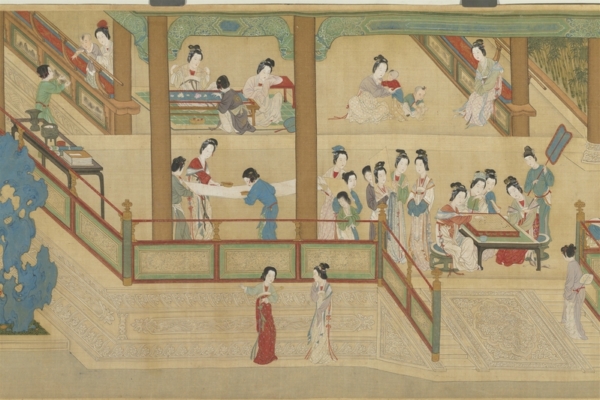Taiwan’s National Palace Museum is introducing the “Qi Ren Yi Shi” ancient Go culture special exhibition this summer. The exhibition showcases over sixty selected paintings, calligraphies, documents, and artifacts from the Han to Qing dynasties in the museum’s collection, depicting emperors, generals, literati, monks, celestial beings, and court ladies, extending to the contemporary Taiwanese Go scene, presenting the diverse facets of Go culture.
The museum explains that the exhibition also presents ancient Go manuals and equipment, covering chess, backgammon, and other intellectual games, suitable for parents and children to explore together, appreciating the millennium-old wisdom of ancient people on a square chessboard.
Curator at the National Palace Museum, assistant researcher Cai Junyi, points out that despite the small size of the chessboard, it is like a small universe within a square inch, containing endless wisdom of life. Go is not only one of the “Four Arts” (qin, chess, calligraphy, and painting) beloved by literati throughout the ages but also a cultural memory circulating in palaces, temples, boudoirs, and streets. This ancient intellectual activity, originating from the upper class of Chinese society, has been transmitted for thousands of years to the folk in East Asia, and still exhibits vigorous vitality in the global sports, digital, and animation fields.
Cai Junyi mentions that this exhibition themed “Qi Ren Yi Shi” takes the alternative names of ancient Go, “Qi” and “Yi,” and narrates the “strange tales” that happen when different characters meet Go from various perspectives and historical scenes. The ancients viewed people through Go, cultivating their characters through the game, emphasizing emotional exchanges during the process and contemplation on life.
Even if one is not a master of Go, as Cai Junyi underlines, one can still enjoy a moment of tranquility and find a rhythm of living calmly in a game, perhaps this is the profound revelation that Go brings to modern people. Welcome both young and old to step into the small universe of Go culture, to experience the wisdom of life and historical charm between chessboards, and to continue writing our own “Qi Ren Yi Shi”.
The National Palace Museum states that Go was originally invented as a game simulating warfare, a game that exercises mental acuity and strategy, deeply favored by nobles and military officials since ancient times. The national treasure of the National Palace Museum, the “Seated Statue of Emperor Taizu of Song Dynasty,” depicts Zhao Kuangyin, the founding emperor of the Song Dynasty, is the only full-body image among the four Taizu statues in the collection, with the rest being half-body images.
According to the museum, it is said that before Taizu ascended the throne, he gambled in chess with the Taoist recluse Chen Tuo, even wagering Mount Huashan, but ended up losing. After his accession, he fulfilled his promise by exempting Huashan from taxes, spreading the legendary story of “winning a game at Mount Huashan,” showcasing the gambling customs of kings and officials using mountains and lakes as bets, contrasting sharply with the elegant gambling interests of literati in scholarly pursuits.
Apart from playing Go, Go culture has also spawned various and changing play styles, and “dàn qí” is one of them. The National Palace Museum explains that “dàn qí” originated in the Han Dynasty, using Go pieces and boards instead of Cuju (ancient football), similar to today’s finger football, where players flick chess pieces into the opponent’s territory, widely favored by the royal and nobility due to its ease. The enduring work “Song Zhao Boju at Shuige Playing Go” illustrates two individuals leisurely playing Go in a waterside pavilion.
The National Palace Museum shares that the national treasure “Spring Dawn in the Han Palace” by Chou Ying has a meticulous composition and exquisite brushwork, representing the theme of “Spring Dawn in the Han Palace.” The painting depicts concubines in the palace garden admiring flowers, frolicking in the grass, playing music, dancing, engaging in grooming, embroidery, childcare, and literary activities such as playing musical instruments, playing Go, calligraphy, and antique appraisal, showcasing the elegant and diverse daily life of palace ladies.
The museum says that this exhibition particularly plans the segment “Taiwan Go Scene Wind and Cloud,” presenting the exciting journey of Taiwanese Go players rising on the international stage. Lin Haifeng went to Japan at a young age, creating the legend of Taiwanese Go players reaching the top of the Japanese Go world; renowned as the “Red-faced Chess King,” Zhou Junxun won the LG Cup championship, securing Taiwan’s first world chess champion title; the new-generation Go king, Hsu Haohong, won the gold medal at the Hangzhou Asian Games, marking Taiwan’s first Asian Games gold in Go history. Through these players and related exhibition pieces from significant competitions, the splendid journey of Taiwanese Go from local cultivation to the international stage is showcased.
To promote Go culture, the National Palace Museum encourages participation from all generations and will hold the “National Palace 100・Qi Ren Yi Shi Go Tournament” on August 17. This will be the first-ever Go event in a century, with all three hundred slots for participants filling in a flash. Starting from 9:30 a.m. on that day, the main B1 exhibition hall of the museum’s northern campus will host the “Top Invitational Tournament,” featuring eight professional and amateur players in an exciting match. This summer, both young and old are welcomed to the National Palace Museum to enjoy watching the tournament, appreciating the centennial exhibition “Qi Ren Yi Shi – Ancient Go Culture,” experiencing the profound charm of Go culture that spans across a thousand years.

